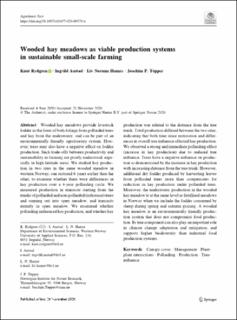| dc.contributor.author | Rydgren, Knut | |
| dc.contributor.author | Austad, Ingvild | |
| dc.contributor.author | Hamre, Liv Norunn | |
| dc.contributor.author | Töpper, Joachim Paul | |
| dc.date.accessioned | 2023-05-12T10:03:50Z | |
| dc.date.available | 2023-05-12T10:03:50Z | |
| dc.date.created | 2020-12-01T10:28:14Z | |
| dc.date.issued | 2020 | |
| dc.identifier.issn | 0167-4366 | |
| dc.identifier.uri | https://hdl.handle.net/11250/3067748 | |
| dc.description.abstract | Wooded hay meadows provide livestock fodder in the form of both foliage from pollarded trees and hay from the understorey, and can be part of an environmentally friendly agroforestry system. However, trees may also have a negative effect on fodder production. Such trade-offs between productivity and sustainability in farming are poorly understood, especially in high-latitude areas. We studied hay production in two sites in the same wooded meadow in western Norway, one restored 6 years earlier than the other, to examine whether there were differences in hay production over a 4-year pollarding cycle. We measured production in transects starting from the trunks of pollarded and non-pollarded (reference) trees and running out into open meadow, and transects entirely in open meadow. We examined whether pollarding influenced hay production, and whether hay production was related to the distance from the tree trunk. Total production differed between the two sites, indicating that both time since restoration and differences in overall tree influence affected hay production. We observed a strong and immediate pollarding effect (increase in hay production) due to reduced tree influence. Trees have a negative influence on production as demonstrated by the increase in hay production with increasing distance from the tree trunk. However, additional dry fodder produced by harvesting leaves from pollarded trees more than compensates for reduction in hay production under pollarded trees. Moreover, the understorey production in the wooded hay meadow is at the same level as fertilized meadows in Norway when we include the fodder consumed by sheep during spring and autumn grazing. A wooded hay meadow is an environmentally friendly production system that does not compromise food production. Its tree component can also play an important role in climate change adaptation and mitigation, and supports higher biodiversity than industrial food production systems. Canopy cover, Management, Plantplant interactions, Pollarding, Production,Tree-influence | en_US |
| dc.language.iso | eng | en_US |
| dc.rights | Navngivelse 4.0 Internasjonal | * |
| dc.rights.uri | http://creativecommons.org/licenses/by/4.0/deed.no | * |
| dc.subject | Canopy cover | en_US |
| dc.subject | Management | en_US |
| dc.subject | Plantplant interactions | en_US |
| dc.subject | Pollarding | en_US |
| dc.subject | Production | en_US |
| dc.subject | Tree-influence | en_US |
| dc.title | Wooded hay meadows as viable production systems in sustainable small-scale farming | en_US |
| dc.type | Peer reviewed | en_US |
| dc.type | Journal article | en_US |
| dc.description.version | publishedVersion | en_US |
| dc.rights.holder | © 2020 The Authors,under exclusive licence to Springer Nature B.V. part of Springer Nature 2020 | en_US |
| dc.subject.nsi | VDP::Zoologiske og botaniske fag: 480 | en_US |
| dc.subject.nsi | VDP::Zoology and botany: 480 | en_US |
| dc.source.pagenumber | 165-176 | en_US |
| dc.source.volume | 95 | en_US |
| dc.source.journal | Agroforestry Systems | en_US |
| dc.identifier.doi | 10.1007/s10457-020-00570-x | |
| dc.identifier.cristin | 1854697 | |
| dc.relation.project | Norges forskningsråd:xxxxxx | en_US |
| cristin.ispublished | true | |
| cristin.fulltext | original | |
| cristin.qualitycode | 1 | |

